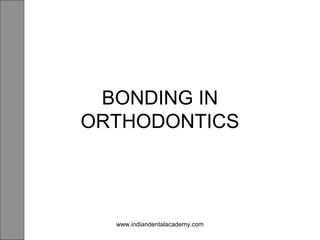The document discusses orthodontic bonding, detailing its advantages over traditional banding methods, such as improved aesthetics and comfort. It covers the history and development of bonding techniques and materials, including various adhesive types like chemical, light, and dual-cure systems. Key bonding procedures, necessary preparations, and challenges faced during bonding are also analyzed, emphasizing the importance of enamel conditioning and material choice.































![When indicated, Banthine tablets (50 mg
per 100 lb [45kg] body weight in a
sugar-free drink 15 minutes before
bonding may providing adeduate
results
www.indiandentalacademy.com](https://image.slidesharecdn.com/bondingaftab-160507090820/85/Bonding-aftab-32-320.jpg)

























































































































